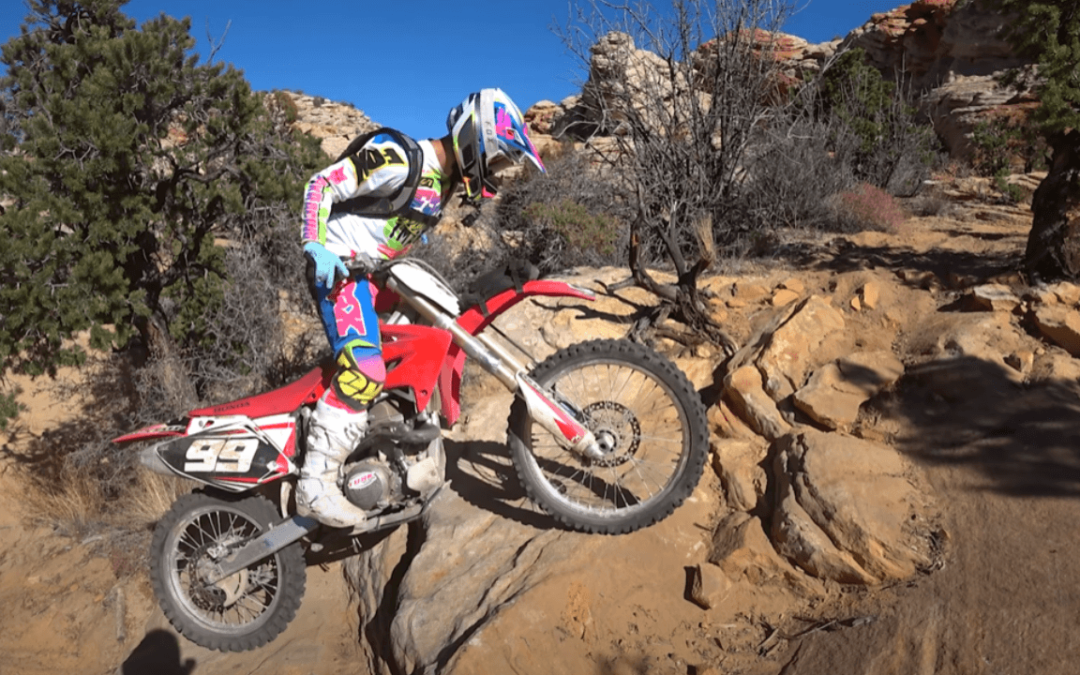Riding dirt bikes attracts both adults and younger audiences alike, most likely due to its considerable risk factor. As humans, some of us have a “novelty seeking” trait, which according to psychologists, makes us have a consistent drive for unexpected (and often dangerous) situations.

People who have this characteristic get easily bored and are much more impulsive than others, particularly at a young age – hang on to this information since it’ll make sense a bit further down.
Dirt bike riding is an extreme sport that doesn’t come without its fair share of risks. Injuries and accidents are quite common, as you can see from the stats down below:
Dirt Bike Accidents Statistics
Even though just a tiny share of all dirt bikes belong to professional riders, more than 50% of all dirt bike injuries happen during official races (Supercross and Motocross). From this information, we can assume riding a dirt bike as a hobby tends to be safer than doing it professionally.
The following numbers aim to display the bigger picture regarding dirt bike accidents:
- Not wearing a helmet remains the #1 factor in dirt bike riding fatalities, with over 60% of accidents leading to death. [Source] This is why it is crucial for every dirt biker to own a proper dirt biking helmet.
- The second-most-common death cause (nearly 50%) goes to riding under the influence (drunk riding and riding without a helmet frequently overlap). [Source]
- From 2006 to 2012, off-road bike riding fatalities decreased by 30%. From 2012 to 2017, this number has remained roughly the same. [Source]
- From 2002 to 2006, a total of 34,457 patients required hospitalization from off-road injuries. From that total, only 9,875 people were riding dirt bikes, while the rest were ATV-related. [Source]
- Dirt bike riding (as well as most extreme sports) appeals significantly more to men than women. Of all accounted fatalities, 90.5% were male. [Source]
- From all bone fractures connected to dirt bike riding, only 35% were above the waistline, while 65% of them happened below it. [Source]
- In professional Motocross races from 2000 to 2007, 249 unique patients got admitted into a level 1 trauma center. Nearly half of them required hospitalization, and about a third required surgery. [Source]
- According to the National Electronic Injury Surveillance System (NEISS), from 2007 to 2012, there were more than 1,570 dirt bike riding injuries involving extremity fractures, with a vast majority of lower extremity fractures. [Source]
- Off-road riders are less likely to sustain blunt abdominal trauma, blunt chest trauma, skin trauma, and death than on-road riders. [Source]
- In 2018, 4,675 motorcycle accidents led to death. However, from this total, only 74 were caused by dirt bike riding. [Source]
Dirt Bike Injuries Statistics
According to the Center for Disease Control (CDC), from 2001 to 2004, the following stats summarize all non-fatal injuries related to dirt bike riding in people under the age of 19: [Source]
- Each year, emergency departments (EDs) in hospitals scattered across the US admitted roughly 23,800 off-road riders.
- From all injured riders, patients under 16 represented 69.9%.
- About 88.4% of patients were male.
- Of all admitted patients, 97.1% were riding the bike, meaning 2.9% became injured either riding along or collaterally as innocent bystanders.
- In terms of location, riders injured in properly-defined Motocross areas were more likely to need hospitalization than those injured in other off-road spots (14.9% v. 5.6%).
- From all patients’ narratives, we can conclude that 8.9% of all injuries happened during a bike jump, and about 5.3% of the total were a result of crashing into another off-road vehicle.
- About 39.1% of all cases were “serious” (fractures and internal injuries). From the total, 35.6% came from fractured extremities (and from this number, head and neck injuries represented about 16.8%).
In 2003, American customers bought more than 300,000 dirt bikes (twice as much as 1999). From a macro point of view, most off-road riders today are white, under 30, residents of non-metro areas, and have less than one college degree. [Source]
Since 2000, the American Academy of Pediatrics has advised parents not to let their children under 16 participate in this extreme sport. The logic behind it is that riding a dirt bike (safely) would require skills and proper judgment that a child that age could not possibly yet have.
There’s plenty of scientific data to back this up, as the following study from the McLean Hospital Brain Imaging, in Boston, MA. [Source]
The study claims that, as we grow older, our brain activity shifts from the amygdala (responsible for our “gut feeling” or so-called instinct) to the frontal lobe (our impulse and desire inhibitor).
In other words, as we approach our twenties, we’re still learning how to control our impulsive behaviors, even more so when driven by that “novelty seeking” trait we mentioned earlier.
With all that said, we can understand why dirt bike riding appeals to kids and teens so much – there’s even scientific data to prove that “boys will be boys” is more than just a saying. The only thing left for us to do is to guide these kids, protect them and teach them how to have fun safely and responsibly – so they don’t become yet another statistic.



